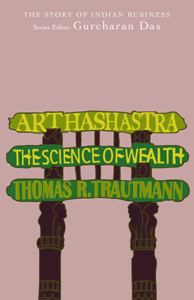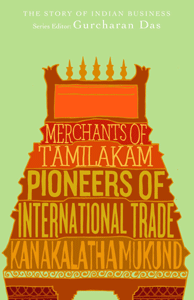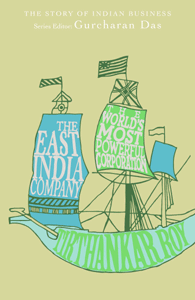The Story of Indian Business
By Sarang Chari | 07 Apr 2012
Arthashastra: The Science of Wealth
Author: Thomas Trautmann
Publisher: Penguin Books India
Price: Rs399
Classification: Non-fiction
Merchants of Tamilakam: Pioneers of International Trade
Author: Kanakalatha Mukund
Publisher: Penguin Books India
Price: Rs399
Classification: Non-fiction
The East India Company: The World’s Most Powerful Corporation
Author: Tirthankar Roy
Publisher: Penguin Books India
Price: Rs399
Classification: Non-fiction
As far as non-fiction works on history go, this multi-volume series on business is a definitive page-turner. The slim volumes in large font make good reading. It is not for nothing that these scholars on various aspects of Indian business have closely examined texts on great ideas that have shaped commerce on the Indian subcontinent. The writers and editors had a vision, a plan, about the larger scheme of things. Clearly, in this case, the whole is greater than the sum of its parts. Not that there is a dull moment in any of the constituent books; on the contrary, each book stands on its own as an exhaustive treatise within its sphere of relevance.
 In Arthashastra: The Science of Wealth, the renowned Thomas Trautmann pens a descriptive analysis of the original masterpiece by Kautilya (Chanakya). Of course, as the writer points out, the answer to the question as to which era the original belongs to is open to debate. Replete with passages from the original, the book paints a vivid picture of life when the masterpeice was written. The science of economics is the underlying philosophy of the book. Identifying wealth with kingship, Trautmann talks about artha as wealth in the extended sense of worldly success, which includes political power. Kings were regulators of business and entrepreneurs. This book has much to offer businessmen and regulators of the present day and age.
In Arthashastra: The Science of Wealth, the renowned Thomas Trautmann pens a descriptive analysis of the original masterpiece by Kautilya (Chanakya). Of course, as the writer points out, the answer to the question as to which era the original belongs to is open to debate. Replete with passages from the original, the book paints a vivid picture of life when the masterpeice was written. The science of economics is the underlying philosophy of the book. Identifying wealth with kingship, Trautmann talks about artha as wealth in the extended sense of worldly success, which includes political power. Kings were regulators of business and entrepreneurs. This book has much to offer businessmen and regulators of the present day and age.
 Merchants of Tamilakam: Pioneers of International Trade by Kanakalatha Mukund is a well-researched piece, which, drawing from epics written when Jainism and Buddhism were in the ascendant in Tamilakam (a deliberate choice over Tamil Nadu, for which the author makes a compelling case), also takes us through the rise of the great Hindu kingdoms of the south and the decline of the mighty Chola empire; all this, without losing sight of the main objective of the book: to chart the life and times of Tamil merchants who impacted the political and economic development of South India through the ages. Her grasp of the subject is masterly and her attention to detail, recounting everything from the mundane to the wonderful, delectable. Mukund’s discussion on the long reign of Tamil dynasties lends credence to the theory that political stability begets investment and consequently promotes prosperity and economic development.
Merchants of Tamilakam: Pioneers of International Trade by Kanakalatha Mukund is a well-researched piece, which, drawing from epics written when Jainism and Buddhism were in the ascendant in Tamilakam (a deliberate choice over Tamil Nadu, for which the author makes a compelling case), also takes us through the rise of the great Hindu kingdoms of the south and the decline of the mighty Chola empire; all this, without losing sight of the main objective of the book: to chart the life and times of Tamil merchants who impacted the political and economic development of South India through the ages. Her grasp of the subject is masterly and her attention to detail, recounting everything from the mundane to the wonderful, delectable. Mukund’s discussion on the long reign of Tamil dynasties lends credence to the theory that political stability begets investment and consequently promotes prosperity and economic development.
 The East India Company: The World’s Most Powerful Corporation, the third book in the series, is by far the fastest-paced. This one actually reads like a novel, with new ‘characters’ and ‘plot twists’ introduced every few pages. While history textbooks dwelled upon the battles, they did leave a lot to imagination. This book, instead of drowning in a sea of information, does well to provide context to those very events we knew to have been clinchers for the East India Company in India. The whole range of the company’s actions, from bribery and manipulation (whether for self-preservation or plain greed, is for us to decide), to nation-building and heroism, is laid bare. The origin of joint stock, the intricacies of the company’s relationship with Indian agents, the state of trade and commerce in India before and during the company’s rule, the company’s frosty relations with London, and the advent of classical economics and the Industrial Revolution are some of the topics the author touches upon. For all the talk about pure economics, the fact remains that, in every period of history, politics and economics have been intertwined like a double helix. Tirthankar Roy is a professor at the London School of Economics and a noted scholar on Indian economic history; he rises above petty rhethoric, persecutory delusions and self-pity, to objectively analyse and arrive at the reason why a trading company came to build an empire in India.
The East India Company: The World’s Most Powerful Corporation, the third book in the series, is by far the fastest-paced. This one actually reads like a novel, with new ‘characters’ and ‘plot twists’ introduced every few pages. While history textbooks dwelled upon the battles, they did leave a lot to imagination. This book, instead of drowning in a sea of information, does well to provide context to those very events we knew to have been clinchers for the East India Company in India. The whole range of the company’s actions, from bribery and manipulation (whether for self-preservation or plain greed, is for us to decide), to nation-building and heroism, is laid bare. The origin of joint stock, the intricacies of the company’s relationship with Indian agents, the state of trade and commerce in India before and during the company’s rule, the company’s frosty relations with London, and the advent of classical economics and the Industrial Revolution are some of the topics the author touches upon. For all the talk about pure economics, the fact remains that, in every period of history, politics and economics have been intertwined like a double helix. Tirthankar Roy is a professor at the London School of Economics and a noted scholar on Indian economic history; he rises above petty rhethoric, persecutory delusions and self-pity, to objectively analyse and arrive at the reason why a trading company came to build an empire in India.
I could go on and on about these books, but alas I have to put down my pen. Wait, there’s someone I completely forgot. Gurcharan Das. The best thing about his forewords to these books is that they aren’t run-of-the mill in that they strike a chord with the reader. The famous Indian writer, instead of going over the same territory as the book, provides useful background information and paves the way for a more detailed exploration of the subject.






















